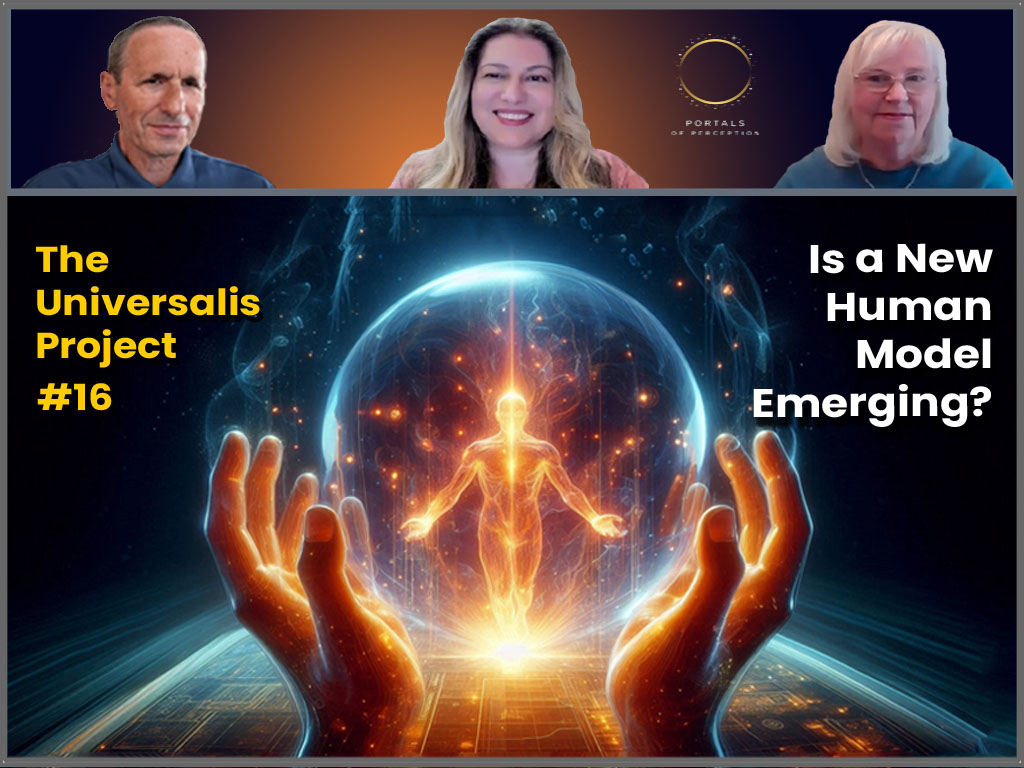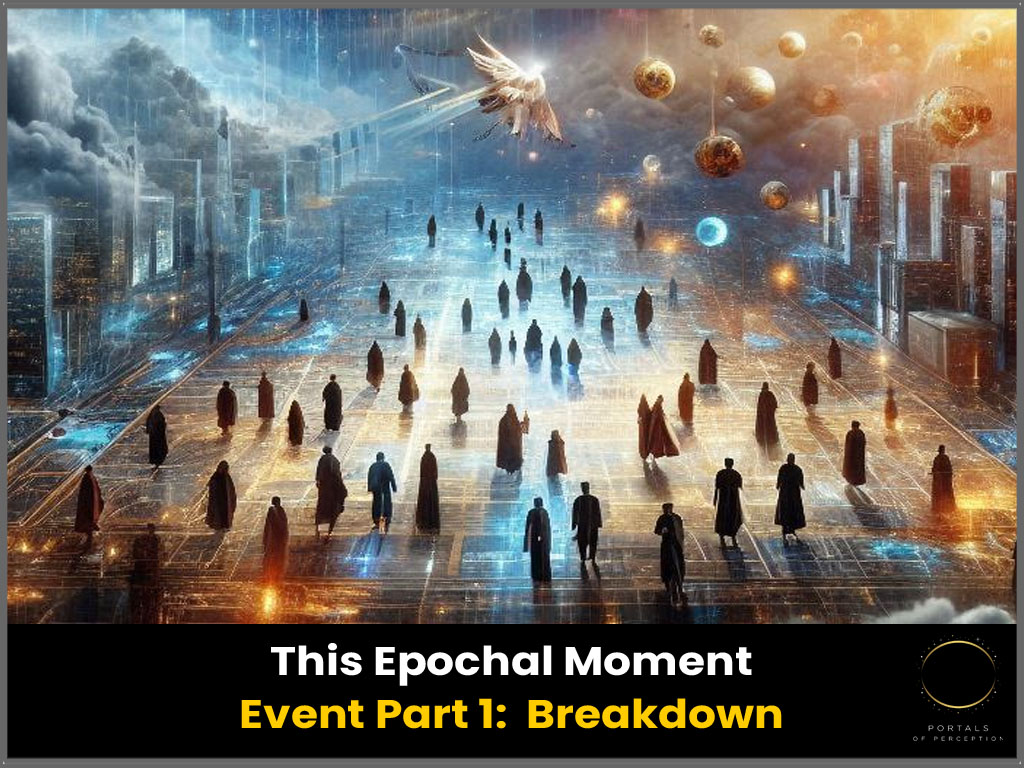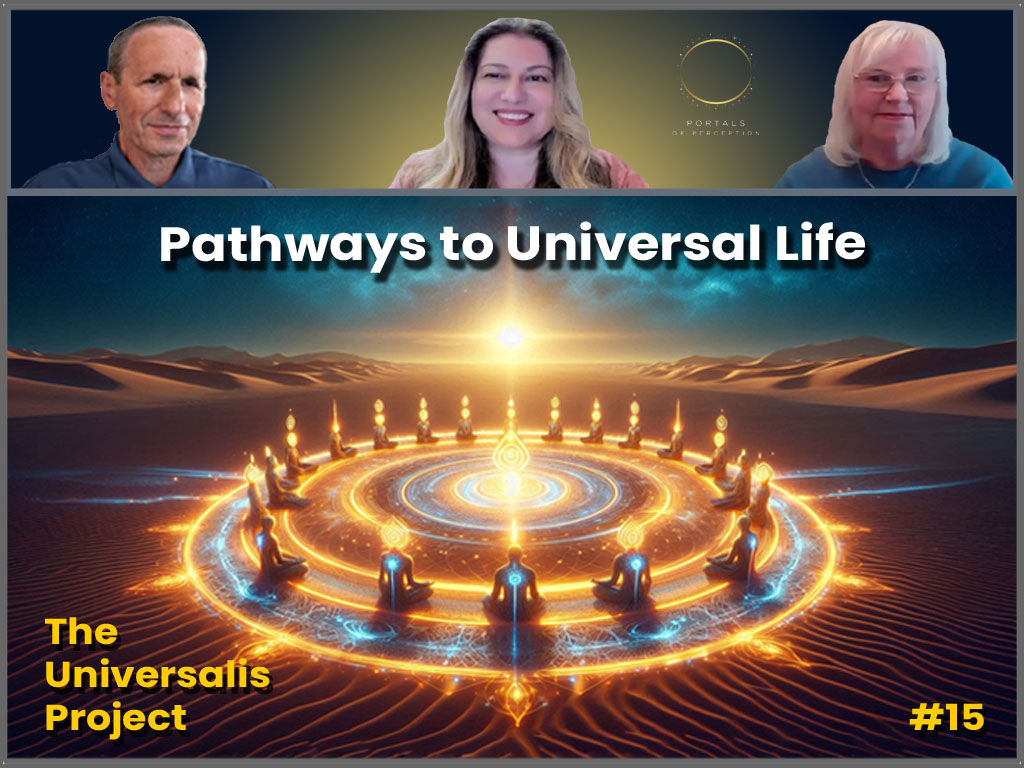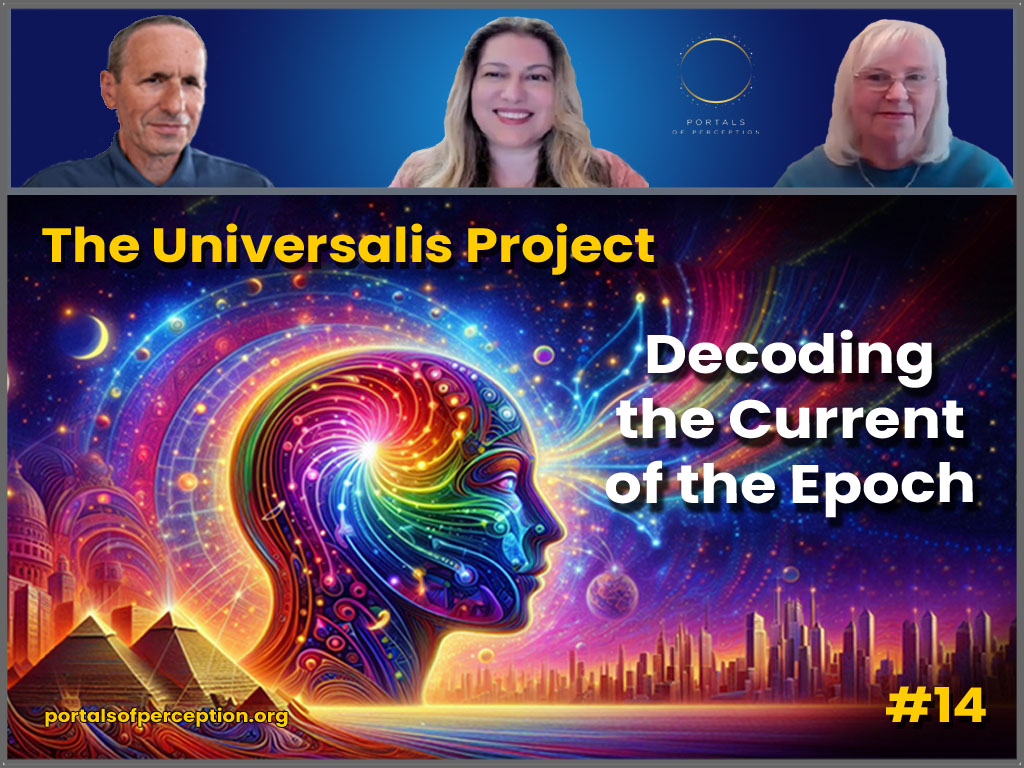
A location note: This article builds on the insights explored in The Ensoulment Journey conversation between Aviv Shahar and Jeff Vander Clute that took place in early March 2022. Aviv describes working through The Three Journeys with a global community at an event that took place just as the Russian invasion of Ukraine was getting underway. The beginning of their conversation addresses the challenges of entering deep transformational and spiritual inquiries under the influence of a kinetic war. Aviv sought to answer this challenge during the event and invited everyone present to facilitate together the space-making effort. Jeff and Aviv have been holding Portals conversations for several years to follow the emerging journey work of the Epoch Culmination community endeavor.
Inside the turmoil of converging global crises and disruptive changes underway, many are trying to make sense of what’s happening in the world, and inquire about the meaning and purpose of life in a new and revitalized way. We are experiencing a natural need to find anchor in something we can understand and trust. We are seeking to find a context and/or an ecology that’s connected to a greater truth and offers nourishment, comfort, a sense of hope, and direction.
The Three Journeys is an attempt to bring to currency the age-old quest for a source of meaning. Part 1 develops an introductory context. Part 2 will describe the multifaceted natures of The Three Journeys.
Pilgrim’s Progress-like tales narrating the journey from the "City of Destruction" ("this world"), to the "Celestial City" appear in many traditions and cultures. Indigenous tribes all over the world conduct rites of passage to adulthood that vary in proceedings and context, but share three distinct characteristics. They typically involve a temporary separation from the community (leaving the familiar); a symbolic change and transition entry into a new realm, the liminal (a time of testing, learning, and growth), and then a return to the community (reintegration). Note 1
This quest-initiation-return journey is also inseparably interwoven in the religious scriptures and the life stories of all the instigating figures and prophets of the known religions. Note 2 It’s elaborately recounted in literature in many myths, epic novels, poems, theatrical plays, and even comics, as well as in the filmography of countless hero movies.
Joseph Campbell maps in “The Hero’s Journey” an all-embracing metaphor for the deep inner transformation that heroes in every time and place seem to share, a path that leads them through great movements of separation, ordeal, and return. Note 3
How does this three-fold journey play out today in the context of a postmodern, noisy, and cacophonous world, that has largely replaced the traditional vision quest rites with packaged enlightenment retreats?
So much of the current environment and context lure us to shortcuts and to spiritual ‘bypass’, even perhaps to the ludicrous idea of instant illumination by a TikTok video. Still, in most situations, a true, genuine insight requires more from us. We need to earn, embody, apply, and share the insight, to bring its transformative power to life.
Then there is a second, even more critical question. Once we stumble on a novel revelation, experience elevation, enter a presence that opens our heart and affords us a new awareness and perception about ourselves, or the nature of life and the universe, what do we then do? How do we work with this new opening so that it is not only a transitory state?
Once a contact is made with a source that fills us with inspiration, awakens us in a whole new way and offers glimpses at the prospects of a higher perception, how do we process these experiences in ways that generate continual and embodied development? These conundrums contain the holy grail searchers and pilgrims throughout the ages grappled with. The many variations of the Hero’s Journey tales offer reflections on the traps and the obstacles along this discovery path.
The Three Journeys endeavors to bring this conundrum into an updated currency and offer a way to reimagine the searcher’s quest in a contemporary context.
In this introductory part and in part two of this exposition, we are seeking to describe and map:
• How have recent centuries influenced and shaped the esoteric and spiritual quest?
• What are The Three Journeys?
• What are the traps the Ensoulment Choice must overcome, and what are the pathways to embark on the Ensoulment Journey?
• What is the qualitative difference between the first journey of escaping the world to contact a source, to the third journey, to be joined to the source in service to its evolution?
Preamble to The Seeker’s Journey – A Brief Historic Detour as Context
Recent decades have unleashed countertrends that attempted to recast and rebalance the separation of the outer and the inner worlds. Many are seeking to find answers and reintegrate the whole person in workshops, retreats, festivals, and in a variety of somatic, therapy, healing, mindfulness, relational, and communal experiences, practices, and rituals, including psychedelic experimentation.
Far from romanticizing or idealizing the pre-modern world, our endeavor is to examine how the modern and then postmodern world fashions the challenges and opportunities of the pilgrim’s quest. What enabled the modern project?
The modern world was powered by innovative developments that extracted and harnessed natural resources and the almost free energy fortune found in the ground. Humanity has since been burning this oil at a rate many million times faster than it took planet Earth to capture this solar power and convert it into a storable energy form. These extractive capacities married with entrepreneurial ingenuity and profit-making dynamics enabled the acceleration of industrialization and the economic growth central for the modernity project. These dynamics became part of the modern ethos. Note 4
In a classic reversal capture, the early idealistic pioneers of the Internet, who brought postmodern do-no-evil redemptive tendencies, were quickly caught by the extraordinary profit opportunities it unlocked. This time, the extractive ethos moved from mining for natural resources in the ground to mining personal, psychological, and behavioral data in all of us. The last unconquered continent, the brain and unconscious mind, became the project of the most sophisticated labs in Silicon Valley.
These are some of the socioeconomic and cultural dynamics any searcher of esoteric truth, genuine development, transcendence, embodiment, and enlightenment will now encounter. But there is even more to encompass and consider.
Celebri-tocracy: The Postmodern Summersault Versus Our True Noble Nature
The parallel challenge arising in this is that we now live and breathe in a paradigm that prioritizes and celebrates the ultra-success myth, a curious case of a modern/postmodern summersault. Aristocracy played an important social and cultural role in traditional societies. With the rise of democratic free market economies and the modernity project getting underway, traditional aristocracy was supplanted by the idea of meritocracy.
Instead of status and elevation afforded by bloodlines, the shift represented the opportunity and the value placed on initiative, creativity, entrepreneurial ingenuity, dedicated hard work, and achievement. A novel cultural development, central to the modern project. Still, the removal of the royals and the nobles created a social and cultural void that produced a cultural artifact in elevating celebrities and socialites to substitute and fill the space. Art, entertainment, sport, business, and political celebrities became the modern substitute for the royals.
"Human societies still needed to elevate individuals we could love and hate, and to project onto, all that we wish for ourselves, as well as to criticize and condemn all the shortfalls that we have not yet learned to integrate. To retether our core thread of the pilgrim’s quest, let us seed here a radical idea central to our premise.
At core, the searcher’s quest for meaning and purpose carries the potential for human life to discover its own intrinsic noble nature.
The socio-political and economic evolution to merit-based modern paradigm contained this nascent insight that every human is “endowed by their Creator with certain unalienable rights", and ought to be given the opportunity of expressing and realizing their natural genius and higher potential. Note 5
Evolution, however, never works in a straight line. Instead, it moves through cross currents and riptides that confuse and frustrate any dogmatic perspective. New development moves often produce their shadow elements. Enlightening progress tends to unleash its own regressive and suppressive shadowmaking current. If there is an intelligent teleology in the process of evolution, we can imagine and reason regressive cycles to offer the evolutionary process opportunities to correct itself and forever refine the growing fidelity of updated foundations.
The underlying Sapient struggle of the last two centuries is a case in point of these crosscurrents.
To fully embrace the eminent and noble nature of human life, we need to learn to reintegrate the power we project on the people we admire and hate, including the celebrities and leaders we love to despise.
What is the higher eminent potential of being human? It contains the insight that the essence of nobility is not “out there” in some special other people, but rather is latent "in here" inside each one of us.
Discovering the higher potential inside us humans is the object of the quest.
The holy grail of the esoteric journey propelling people from the beginning of time to search the great mysteries and overcome impossible odds is the integration and embodiment of this power and revelatory insight. If that is indeed the case, and if our attraction to the people we admire is that we see in them elements of the noble human potential we know are latent in us, then, the wise teacher, the magical artist, the inspirational athlete, the compassionate healer, the charismatic leader, will reflect back to us what is latent inside us.
To embrace our fullest power and transcend the fear of being the best version of ourselves, we must disarm the shadow elements and trauma of the misuse of power. This quest to realize who we are becoming on this journey of liberation is the object of The Three Journeys.
Part 2 of The Three Journeys will describe this realization through The Ensoulment and The Spiritualization endeavors.
We will also invite that we truly see and recognize our projection of superpower and majesty onto others and reintegrate these nascent capacities as our own intrinsic noble nature as humans. This is the kind of evolutionary development and maturation we describe as Homo Universalis, and the greater context emanating through The Three Journeys.
In the last two centuries this evolutionary development made heroic progress and painfully vexing retreats and overall humanity has been held back and inhibited. We anticipate the phase-shift we have entered and coming decades will release the creative and evolutionary powers that have been diverted and inhibited.
As described above, the void created by the loss of traditional structures and societal functions held by the barons and royals needed to be filled by new cultural artifacts. The modern social and cultural space that has been hollowed was filled as we suggested by a celebrity culture, we call celebri-tocracy: a culture obsessed with the ultra-successful, the ultrarich, the ultra-famous, the ultra-everything.
Celebri-tocracy is our postmodern way of disowning and refusing to take responsibility for our own creative, connective, and majestic power, as the birth right of becoming human. This too is some of the background scenery confronting any current postmodern or metamodern searcher of esoteric truth, higher communion, meaning, and purpose.
Part of the challenge is how modernity has normalized this paradigm, including how we have been normalized to enjoy and acquiesce to an extreme fixation on consumption. Consuming is naturally part of living, but only a 20th century paradigmatic capture propagated the view of the human mainly as the “consumer,” largely leaving out the creative, life-giving, generative being the human can be.
That too is a resistance confronting the modern and metamodern seeker as the natural urge and impulse to embark on the esoteric quest for development, refinement and purpose is overwhelmed by a plethora of sensational short-term stimulations and instant luxurious gratifications. As a first principle the challenge is not moralistic; it is psychospiritual, developmental, and ecological. One attempted answer at addressing this challenge has been the monastic path and/or the Amish way of life.
In our exploration here we are tasking ourselves with describing an esoteric quest by way of being in this world and its many challenges and opportunities. At the same time we’re striving for the higher freedom and elevation that await us humans when we fully embrace who we are becoming. This is easier said than done, because these multifaceted dynamics mount several challenges standing in the way of the searcher, seeking to find meaning, and purpose, and unlock the mysteries of eminent living and the higher communion of life.
The good news is that the ground is swelling, and new generations of seekers and leaders intuitively recognize that solving the multiple predicaments that shape the meta civilizational crisis we face are inextricably linked to embracing this evolutionary potential.
In Part 2 of this series, we will describe in depth The Three Journeys, their prospects, challenges, and opportunities.
Notes
1 Rites of passage to adulthood appear in the tradition of many indigenous tribes. They include the Native American vision quest, a rite of passage undertaken at puberty by young boys of the Great Plains Indigenous tribes, as an attempt to find a vision of a future guardian spirit, through the process of fasting, isolation, and meditation. It was important to escape the normal surroundings and daily distractions by choosing an area of natural beauty to prepare for a Vision Quest. Similarly, among the Bemba, in African Zambia, coming-of-age rites could last for a month and included secret sayings, and special songs and dances performed in the woods and in an initiation house.
2 Before leading the Israelites out of Egypt, Moses, after killing an Egyptian slave-master who was beating a Hebrew, fled across the Red Sea to Midian (in northwest Arabia) where he lived as a shepherd for 40 years. There, he encountered the Angel of the Lord, speaking to him from within a burning bush on Mount Horeb, which he regarded as the Mountain of God. (Exodus 2:11-15). Jesus Christ retreated in the Judean Desert for 40 days and nights of fasting after his baptism by John, to understand the revelation of his identity given by the voices of his Father at his baptism: “You are my beloved Son, my favor rest on you.”, where he had to face and overcome the temptations (Matthew 4:1-11). In Buddhism, Prince Siddhartha Gautama renounced his wealth, royal responsibilities, and family to embark on a six-year journey to realize full enlightenment and become “The Buddha”. In Islam, tradition states that one day, when he was about forty years old, Muhammad was alone and asleep in the cave named Hira’ on Mount Jabal al-Nour, near Mecca, when he saw before him “like the brightness of the dawn” an angel who commanded that he recite the verses of the 96th Surah of the Quran. The revelations that Muhammad received were conveyed to others in words remote from his world: he was not known to have composed any poetry.
4 A climax of this extractive, profiteering, monopolizing, and exploitation drive can be seen in what is known as “The Scramble for Africa”, also called the Partition of Africa, which was the invasion, annexation, division, and colonization of most of Africa by seven Western European powers during a short period known as New Imperialism (between 1881 and 1914). The 10 percent of Africa that was under formal European control in 1870 increased to almost 90 percent by 1914.The Berlin Conference of 1884, which regulated European colonization and trade in Africa, is usually accepted as the beginning. In the last quarter of the 19th century, there were considerable political rivalries among the empires of the European continent, leading to the African continent being partitioned without wars between European nations. The later years of the 19th century saw a transition from "informal imperialism" — military influence and economic dominance — to direct rule. Sub-Saharan Africa, one of the last regions of the world largely untouched by "informal imperialism", was attractive to business entrepreneurs. Another inducement for imperialism arose from the demand for raw materials, especially ivory, rubber, palm oil, cocoa, diamonds, tea, and tin.
5 “We hold these truths to be self-evident, that all men are created equal, that they are endowed by their Creator with certain unalienable Rights, that among these are Life, Liberty and the pursuit of Happiness. That to secure these rights, Governments are instituted among Men, deriving their just powers from the consent of the governed”. Part from the Declaration of Independence, a document drafted by a committee made up of John Adams, Benjamin Franklin, Thomas Jefferson, Roger Sherman, and Robert Livingston, that was approved by the Continental Congress on July 4, 1776, and that announced the separation of 13 North American British colonies from Great Britain. Thomas Jefferson in a letter to Roger Chew Weightman (June 24, 1826) for the fiftieth anniversary of the adoption of the Declaration, less than two weeks before his death, expressed his belief that the Declaration “be to the world what I believe it will be (to some parts sooner, to others later, but finally to all) the Signal of arousing men to burst the chains, under which Monkish ignorance and superstition had persuaded them to bind themselves, and to assume the blessings & security of self-government. The form which we have substituted restores the free right to the unbounded exercise of reason and freedom of opinion. All eyes are opened or opening to the rights of man.”









